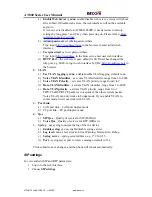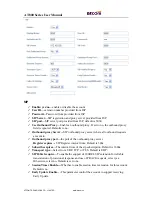
AT800 Series User Manual
ATCOM TECHNOLOGY CO., LIMITED
www.atcom.cn
Any one of a set of terminating events triggers the AT00 to both accept the user-dialed
sequence, and transmit it to initiate a call, or else reject it as invalid. The terminating events
are:
• No candidate sequences remain: the number is rejected.
• Only one candidate sequence remains, and it has been matched completely: the number is
accepted and transmitted after any transformations indicated by the dial plan, unless the
sequence is barred by the dial plan (barring is discussed later), in which case the number is
rejected.
• A timeout occurs: the digit sequence is accepted and transmitted as dialed if incomplete, or
transformed as per the dial plan if complete.
• An explicit ‘send’ (user presses the ‘#’ key): The digit sequence is accepted and
transmitted as dialed if incomplete, or transformed as per the dial plan if complete.
The timeout duration depends on the matching state. White space is ignored, and may be
used for readability.
Digit Sequence Syntax:
Each digit sequence within the dial plan consists of a series of elements, which are
individually matched to the keys pressed by the user. Elements can be one of the following:
Individual keys ‘0’, ‘1’, ‘2’ . . . ‘9’, ‘*’, ‘#’.
The letter ‘x’ matches any one numeric digit (‘0’ ... ‘9’)
A subset of keys within brackets (allows ranges): ‘[‘set ‘]’ (e.g. [389] means ‘3’ or ‘8’ or ‘9’)
Numeric ranges are allowed within the brackets: digit ‘-‘digit (e.g. [2-9] means ‘2’ or ‘3’ or
… or ‘9’)
Ranges can be combined with other keys: e.g. [235-8*] means ‘2’ or ‘3’ or ‘5’ or ‘6’ or ‘7’ or
‘8’ or ‘*’.
Element repetition:
Any element can be repeated zero or more times by appending a period (‘.’ character) to the
element. Hence, “01.” matches “0”, “01”, “011”, “0111” … etc.
Subsequence Substitution:
A subsequence of keys (possibly empty) can be automatically replaced with a different
subsequence using an angle bracket notation: ‘<’ dialed-subsequence ‘:’ transmitted-
subsequence ‘>’. So, for example, “<8:1650>xxxxxxx” would match “85551212” and
transmit “16505551212”.
Intersequence Tones:
An “outside line” dial tone can be generated within a sequence by appending a ‘,’ character
between digits. Thus, the sequence “9, 1xxxxxxxxxx” sounds an “outside line” dial tone after
the user presses ‘9’, until the ‘1’ is pressed.
Number Barring:












































